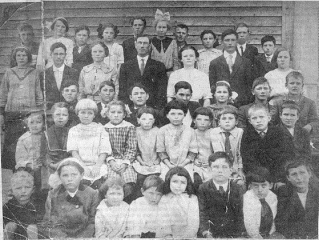 |
 |
 |
 |
This page has been created for the posting of information on early Choctaw Co Schools.
Abstracted by Johnnie Bouck from the book "Geneology of the James Cork I Family" written by Carmen Cork Weatherall
The Cork
School House was built on land donated by James CORK ll and his wife Rebecca
Catherine CORK. James Cork II was the nephew of Rebecca Catherine Cork's
father James Cork l. The Corks also provided the logs for the one
room building. Later the log building was replaced with a two-story frame
school house. The Corks first child, Mary Ann, was born in 1846; their fourth
child, Isabelle, was born in 1851. (Note by JB: The school was probably
built by the time their children needed a school.)
One teacher conducted classes
for all the students grade one through eight. The school was in session for a
term of six months. Class was held from 8:00 AM until 4:00 PM. An
hour lunchtime and a fifteen minute recess in the morning and afternoon allowed
time for games. Some of the games played where hopscotch, drop the
handkerchief, ring around the rosie, hide and seek, pickup sticks, and
marbles. A large ball was used to play
basketball. The baseball was made by wrapping twine tightly around
a small rock.
A spelling bee every Friday afternoon
provided a diversion. After the teacher selected two people to serve as captains of the teams, the
captains took turns choosing students for their team, who
formed a line on opposite sides of the classroom. If
a player misspelled a word, that player was required to sit
down. The winning team was the one whose player was the last one left
standing.
Students either walked or were brought by horse, wagon or buggy. Some
students enjoyed the use of a buggy with a top and celluloid windows which
provided protection from the weather. Ditches which buggies and wagons had
to cross sometimes were across the dirt roads. This required the use of
slabs of wood from the sawmill to make walkways for the students on the side of
the roadway.
The older boys kept wood supplied to the wood burning cast iron heater which
heated the school. A nearby spring provided drinking water. The
water was kept in a bucket with a dipper. All students drank directly from
the dipper. A towel and a pan were provided for use in hand washing.
An outhouse was another necessity.
Cork School closed in
1919. The students were transferred to schools in
Chester or Ackerman.
The following photo was
submitted by Johnnie Bouck. Photo was taken ca1913.
